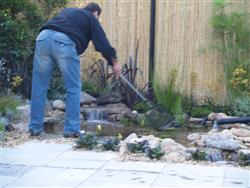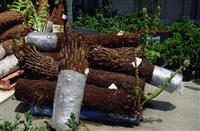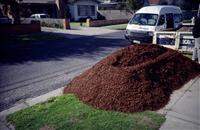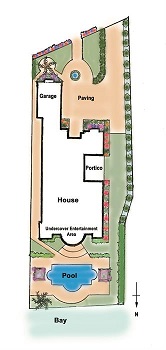 ONLINE COURSE: LANDSCAPING
ONLINE COURSE: LANDSCAPING
Enroll in this qualification today, and study at home, by e-learning
Learn to be a Professional Landscaper, to work in positions such as:
- Landscape Designer
- Landscape Gardeners
- Landscape or Garden Manager
- Landscape Contractor
- Land Rehabilitation Officer, Teacher, Writer
What Do You Study?
There are two parts to this certificate:
A. CORE STUDIES
To develop broad general skills in horticultural practices, and plant knowledge. All students undertaking this certificate will complete these units. The core units comprise approximately 50% of the course content.
The core units consist of the following lessons:
- Introduction To Plants
- Parts Of The Plant
- Plant Culture - Planting
- Plant Culture - Pruning
- Plant Culture - Irrigation & Machinery
- Soils & Media
 Soils & Nutrition
Soils & Nutrition - Seeds & Cuttings
- Other Techniques
- I.D. & Use Of Plants - Landscape Application
- I.D. & Use Of Plants - Problems
- I.D. & Use Of Plants - Indoor & Tropical Plants
- Pests
- Diseases
- Weeds
B. STREAM STUDIES
The stream units are as follows:
- History of Landscaping
- Principles of Design and Planning Information
- Drawing and Costs
- Irrigation
- Garden Designs
 Surveying and Drainage
Surveying and Drainage- Materials
- Paths, Walls and Fences
- Equipment
- Water Features
- Statues, Sundials and Figurines
- Sports
- Landscape Management
- Unions and Workers
- Maintenance
Course Duration: 700 hours
How Does this Differ from the Certificate in Garden Design?
This certificate has a little less emphasis on the design aspects of gardening, and provides more training in horticulture; making it a little more broad based, and more appropriate for someone who is planning to not only design and plan gardens; but also build and maintain gardens.
What Opportunities Exist for Landscapers?
There are lots of opportunities. Many graduates will establish their own businesses. Others will find employment with landscaping companies, parks departments, landscape supply companies, or other enterprises that are involved in planning, creating and maintaining landscapes.
Landscaping Ideas for Small Spaces:
 An article by our Principal, John Mason
An article by our Principal, John Mason
Small spaces can be a real challenge for gardeners, more familiar with quarter acre blocks. They need not be. Some of the most stunning gardens I've ever seen are areas no more than a few metres wide, which with good design and a little imagination, have been turned into the envy of all who visit.
For small areas there is also a challenge to retain sufficient space for other needs, such as entertainment or play, but still have room enough to create the appearance of a comprehensive garden.
Nearly every home will have a small space somewhere that is suitable for creating a garden. Common types of small gardens include:
- Narrow strips between a house or unit and a boundary fence or another building.
- Courtyard gardens
- Balcony gardens on multi storey homes, apartment buildings, etc.
- Rooftop gardens
- Entry areas, particularly for homes with small frontages such as terrace housing.
- Oriental gardens, where landscapes are recreated, or represented in miniature.
BIG EFFECTS IN SMALL SPACES
 Creating an attractive garden in a small area, that won't quickly takeover most of the available space, can be a real challenge. Here are a few ideas:
Creating an attractive garden in a small area, that won't quickly takeover most of the available space, can be a real challenge. Here are a few ideas:
- Choose your plants carefully: - Use plants with fine textured foliage, rather than large leaves. This helps make the garden appear larger. Avoid the use of vigorous or invasive plants. They can quickly takeover closing in the garden, and creating maintenance problems. Use dwarf varieties of plants.
- A winding path, rather than one that goes straight from Point A to Point B makes a garden seem larger.
- Create the optical illusion of distance by having a path with the furthest point from your house or entertainment area slightly narrower than the closer parts of the path.
- The feeling of space can be enhanced by having your garden merge into the house. Glassed entry areas, and the use of indoor plants can help achieve this.
- Small to medium shade trees (deciduous) can be used to provide summer shade and winter light. It is important to choose species that will not have too invasive a root system, or will grow to big for the size of the garden.
- Do not over plant your garden. Remember that plants can grow very quickly once established, and you may find you have no space left to move in ourselves.
- Avoid active colours (eg. red, yellow and orange) as these make small spaces seem smaller. Use colours such as blues, whites, greens and purples to make small spaces seem larger.
- For small gardens that receive limited sunlight use shade-loving plants, such as ferns, begonias, fuchsias, impatiens and balsam. Camellias, dwarf rhododendrons and azaleas make excellent tub plants for cooler sites, while palms, dracaenas and crotons, are good for warmer areas.
- Espaliered trees or shrubs require very little ground space, and are good for small gardens. They can be used to cover walls helping to merge them into the garden, and reducing glare and heat build up. Espaliered fruit trees can be both an attractive addition to the garden as well as providing fruit.
- Dwarf trees can create the image of a much larger garden. There is a huge range of dwarf conifers that would be suitable. Dwarf fruits, such as some of the citrus or dwarf apples, such as the 'Ballerina' range, are not only attractive, but make excellent plants for containers or small beds, as well as providing excellent tasting fruit.
- For long, narrow gardens, such as entry areas, ground cover and low growing plants can be grown to spill over paved walkways to soften the long straight lines of the pathway, to reduce the visual effect of distance. Statues or other features can also be placed at either end of the garden to create a focal point which also reduces the visual effect of distance.
- Tall, narrow, bushy plants can be used to create 'walls' around a garden instead of solid fences or walls. This can help improve ventilation, and can be a lot cheaper than solid fences.
- Design your garden so that it appears that any plants, or attractive features in a neighbours garden appear to be part of yours.
 Painted images and scenes (ie. Tromp l’0liel) on walls around the garden can create a feeling of a much larger space. Plants can be positioned to frame these scenes, and help merge them into the living garden so that they appear as one.
Painted images and scenes (ie. Tromp l’0liel) on walls around the garden can create a feeling of a much larger space. Plants can be positioned to frame these scenes, and help merge them into the living garden so that they appear as one. - A similar approach is to position a large mirror on a wall in a well lit, but protected position so that get back reflected images creating the feel of a much larger garden. The difference between the mirror and painted image is that the reflected images change as you change position.
- Make as much use of the available space as possible, for example, build planting boxes below windows looking out onto the garden, create a raised wall garden or have lots of hanging baskets.
- Place small statues or similar objects at the far end of the garden to give the appearance of distance.
WILL THIS COURSE GET YOU A JOB?
There are many points that need to be considered when you are looking for work and having a qualification is just one of them:
Are you studying the right course? A good course will help you to not only gain knowledge in the field of study it will also help you to experience actual situations that you may encounter in the work place. This is called ‘Experiential Learning’ many courses concentrate on ‘Competency Based Learning’ – just ticking you off against a known list of tasks. Experiential or Problem Based Learning will help you to develop those problem solving skills that are much sought after in employees by commerce and industry.
Are your studies broad enough? In horticulture for example to narrow your focus on one industry sector also narrows your opportunities. A Certificate in Horticulture (core units) will give you those under-pinning horticulture skills that are needed in any inter-industry sector whether you are designing gardens, working in a nursery, working as a gardener etc. You can then use these basic skills to specialise for e.g. Landscaping and Garden Design. Should you want to change sectors later you can still do so because of those basic horticultural skills you acquired by undertaking those fundamental core units.
Are you lifting your profile? No matter what job we are in or hope to get into, networking is the best way to get your name out there and be noticed. Join online social media groups such as linked-in to establish a profile. Make sure you keep it up to date and list your educational and work experience, you would be surprised how many job offers come through these types of networks. Network with industry – attend seminars, industry exhibitions, garden shows etc. and make yourself known; someone may remember you later!
Are your communication skills good? We all remember a good communicator. Communication is not just about being able to hold a conversation with someone though, it also includes writing and technology skills. Today it is essential for everyone to have basic computer skills, good telephone techniques, a respectful way of speaking with others and knowing what is acceptable and non-acceptable behaviour in the workplace.
Are you well-presented? In some horticultural jobs it is almost impossible not to get dirty! Flower growing or crop growing or landscaping is all dirty work. However when presenting yourself for jobs you should be dressed in clean appropriate attire for the job interview you are attending. When you front up for work in the morning do so in clean clothes – it is too easy to think that you’ll get dirty anyway. A tidily presented person will stand out and be more likely to get ahead in their jobs than one who turns up at work in yesterday’s dirty clothes. If you are running your own business good presentation also evokes a feeling of confidence both from you to the customer and from the customer towards you.
Have you chosen the right school? Not all education providers are equal – some will push you through your course just to get you to the end. Others require you to study within set time frames and others give you little support. Many are more about getting that government funding than they are about educating their students.
At ACS:
- We are independent: we do not rely on nor apply for government funding - we are a self-funded school – so we are less caught up in bureaucracy and more into educating our students.
- We allow our students to take their time - when you enrol your course starts - not at a set time of the year. You can then work work your way through the course, with our support, putting in as little or as much time as you can. You can fit your studies around your work or your personal situation.
- We support our students through their studies: we encourage them to contact us and help us to help them, as soon as the smallest problems arise or if they need more information or clarification.
- We want you to succeed!
On completing this course you will be well placed to find employment in horticulture or landscaping; either working for someone (eg. in a garden, nursery or landscape firm); or establishing your own business as a designer and/or builder of gardens.